

A renowned marine biologist captivated students at Woodland Public Schools’ Lewis River Academy with a presentation and hands-on experience with real bones from marine animals on Wednesday, April 26.
After nearly 30 years of visiting Woodland annually, this visit marked John Ford’s return to the district after a nearly three-year pause due to the pandemic.
Ford shared his expertise and enthusiasm, focusing on the fascinating ecosystem that exists beneath the ocean’s surface. Ford’s vast experience studying marine creatures, ranging from giant whales to the smallest tide pool inhabitants, illustrated the diversity and interconnectivity of marine life. Throughout his presentation, Ford emphasized the vastness and significance of marine life.
“With nine out of 10 known animal species residing in the ocean, safeguarding this delicate ecosystem is vital for the wellbeing of our planet,” Ford said in a news release by Woodland Public Schools.
Ford also highlighted the importance of preserving the natural beauty and untouched areas of Washington and Oregon’s coastlines.
“These regions serve as critical habitats for numerous marine species,” he said in the release. “Many visitors to our beaches do not realize that these are preserved habitats, and that humans must be responsible to protect these fragile environments for generations to come.”
Ford’s presentation brought the underwater world to life through vivid descriptions and captivating visuals, the release stated. He introduced students to a variety of sea animals, including sea slugs, such as the sea lemon. Ford shared his fascination with the rare and largest chiton species, known as the Gun Boot, which can only be found in the Pacific Northwest. These introductions sparked curiosity and encouraged students to dive deeper into the wonders of marine life, the release stated.
Ford highlighted the differences between sea otters and river otters, emphasizing that sea otters exclusively swim on their backs, unlike their river counterparts.
“If you ever see an otter in the Columbia River swimming on its back, be sure to give us a call as we have never had sea otters make their way into our rivers,” Ford said in the release.
Ford pointed out that since sea otters have no blubber for insulation against cold water temperatures, their fur is critical in keeping them warm in the ocean.
“A single square inch of a sea otter’s body contains one million hairs,” he explained.
The presentation also focused on the delicate balance within marine ecosystems and the impact of human actions. Ford taught students about the harbor seal’s high-fat milk, which aids in the rapid growth of seal pups within two weeks.
Ford emphasized the importance of not disturbing seal pups.
“Human interaction can cause significant harm to these young animals,” he said. “Many beach visitors think these seal pups need help; however, simply by picking them up, a human causes these pups to have heart attacks out of fear.”
Following his presentation, Ford encouraged the students to have hands-on experiences with a variety of bones, cartilage and other items he brought along.
“Seeing firsthand exactly how big these bones really are can truly widen students’ eyes to the sheer size and expanse of our world’s vast ocean,” Ford said in the release.